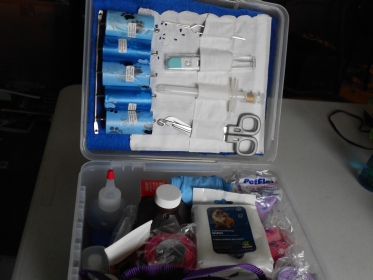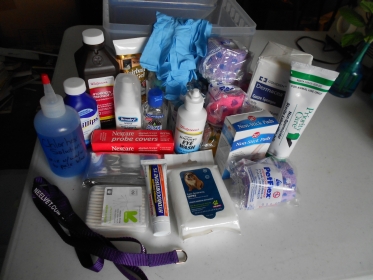An important part of the Water Paws Pet Comfort Station is first aid. Always remember that first aid is not a replacement for an actual vet visit. If a pet needs your first aid, they should also be seen by the animal’s vet as soon as possible. In extreme cases, the animal should see the vet immediately – as in the pet’s guardian/handler should leave the event and take the animal straight to the vet, no stopping for errands along the way.
Most of the items in the first aid kit are things that can be found at a regular pharmacy. There are actually only 6 things you need to get from a veterinary supply, and those are emphasized.

A first aid kit for a pet comfort station.

Items for a first aid kit.
Keep all of this together in a box or bag. The incident log book and a pen should be kept with it. Whenever you treat an animal, give the guardian/handler a card with the veterinary information on it and make a note in your log book. You can get these cards printed at VistaPrint very inexpensively.
To make the animal guardian/handler feel better, you could also get pet bandanas with the Water Paws logo on it to give them (ask to have someone sponsor this!).
First aid training for pets is available at the Red Cross. Your vet may provide you with pet emergency first aid training. Animal rescues and pet shelters may also provide you with emergency pet first aid training. There may also be places like PetTech in your area to provide this training. If all else fails, there's e-Training for Dogs.
There should be at least one volunteer at the pet comfort station at all times with emergency pet first aid training.
No, and you shouldn’t advertise yourself as one, either. Neither should you take legal or medical responsibility for treating others’ animals. But the occasion will arise when you’re faced with a pet in distress, and there are things you can do to lend assistance. The level of care you can offer is based on your own comfort and knowledge level. At the bare, bare minimum, you need to have someone with emergency pet first aid training “on call”, say, one of the nearby EMT’s or other first responders. It’s much better if you or someone at the comfort station has some training. And if you have a vet or emergency clinic “on call” and ready to admit patients from the event – or better yet, available at the event itself – that’s even better.
Remember, you always need an owner/guardian’s permission to render any kind of assistance. If they are balky, give them the contact information for the vet or the animal emergency clinic and advise them to take whatever action needs taking, up to and including an emergency run to the clinic. But it’s their call, and they will do what they choose to do. It is not your responsibility, as much as it may anger or sadden you to see an owner make a choice that is not in their animal’s best interest.
If you do see an instance of outright abuse or neglect of an animal, then you can and should intervene by calling the police or at least informing someone who can help, say, the nearby EMT or vet tech if one is around. Animal abuse and neglect are legal offenses, and should be reported ASAP.
Most states have some form of a “Good Samaritan” law in place that exempts good-faith efforts from ordinary citizens from legal liability when they render assistance to a pet. You can find out more here. And you might be interested in reading about one brave woman who successfully led the fight to enact such a law in her home state of Tennessee.
You might consider posting the following disclaimer prominently in your pet comfort station:
Pet owners and/or guardians retain complete responsibility for their pet’s care, behavior, and well-being. Water Paws provides water, shade, treats, brochures, and minor assistance in basic emergency pet first aid. Pets receiving first aid care must be seen by their veterinarian as soon as possible.
One quick method for testing your dog or cat for dehydration is to “pinch” up the skin on his or her neck. A well-hydrated animal’s skin will return to normal immediately. A dehydrated animal’ skin will remain “tented” for several moments.
If your animal is suffering from sticky eyes, has sticky saliva, or fails the “pinch” test, he is suffering from dehydration and very possibly from heat exhaustion. Getting him or her cared for at the pet comfort station is a good short-term solution, but you need to take your pet to the veterinarian. If your pet is suffering from diarrhea or vomiting, or worse, is stumbling, shaking, having a seizure, or is semi-conscious, you need to drop everything and get your pet to the vet immediately.